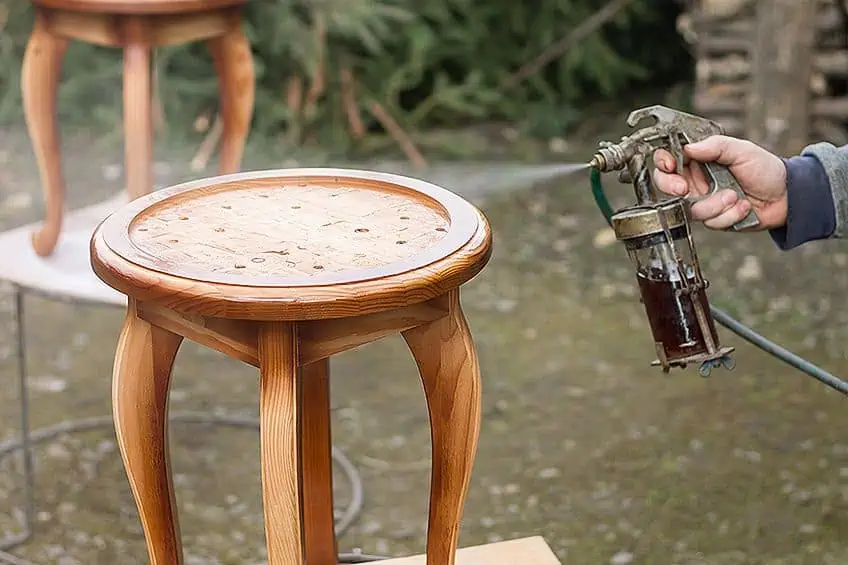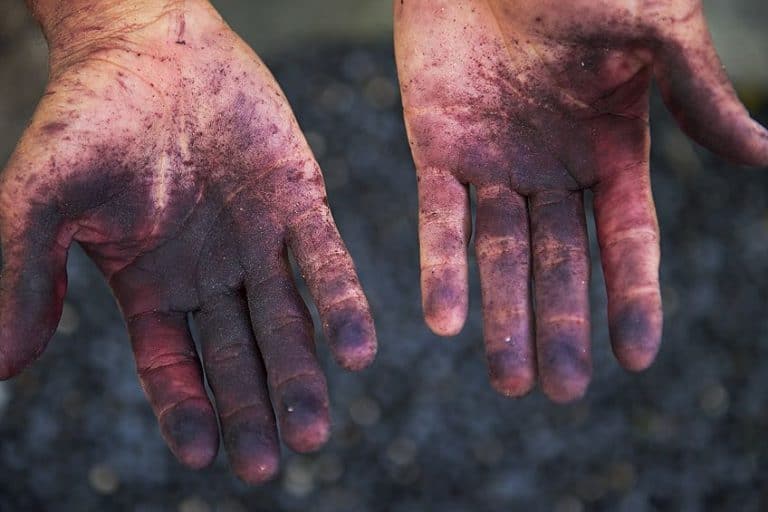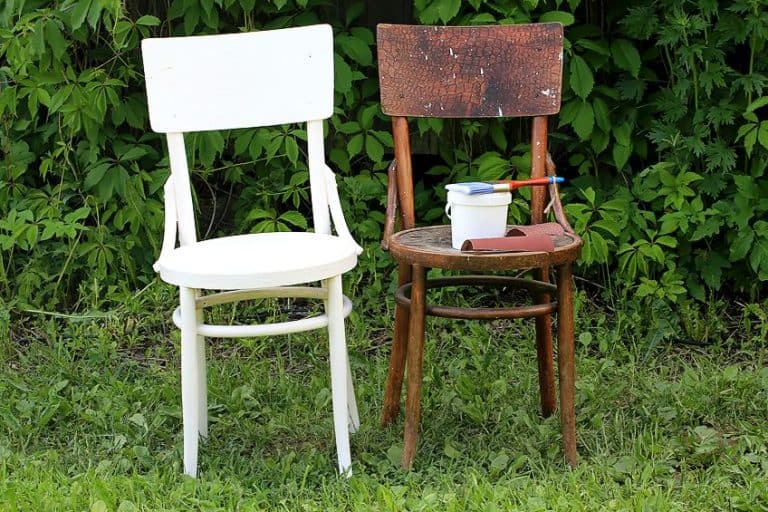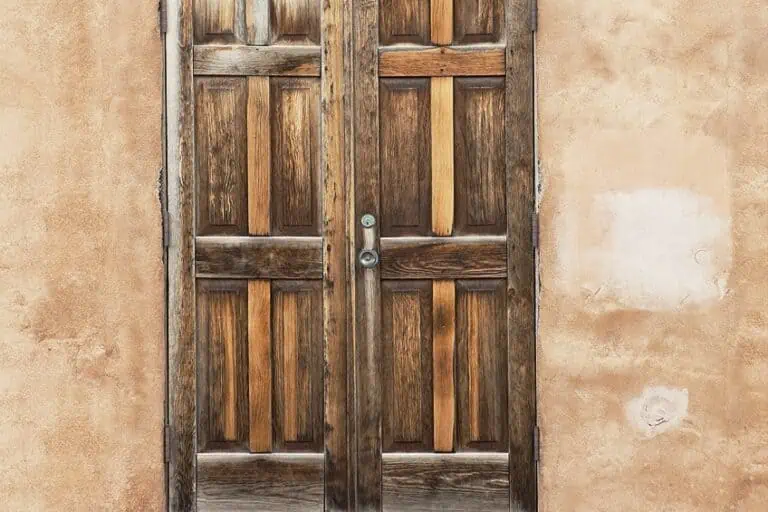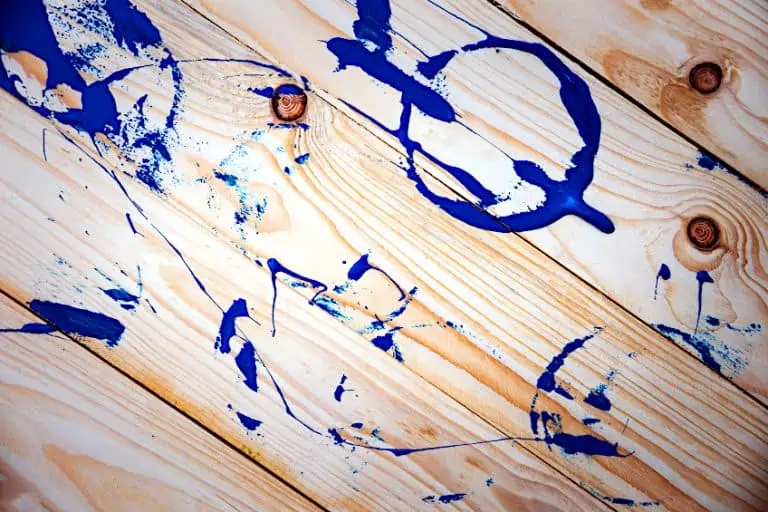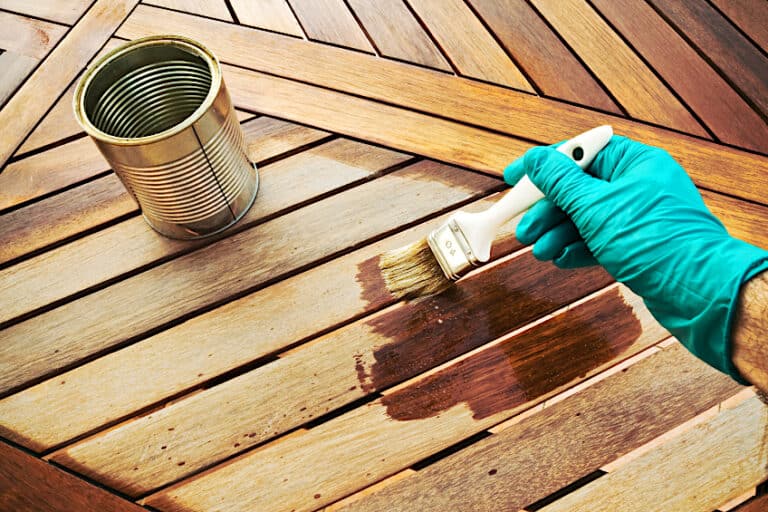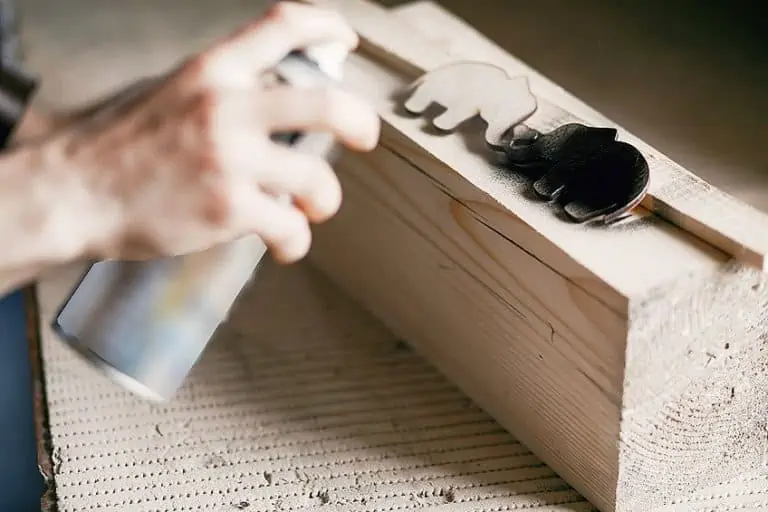How to Spray Paint Furniture – Perfect Surface Guide
A fun and affordable option to update your living room aesthetic is to spray paint your furniture. Spray painting furniture may seem a little overwhelming if you do not have any experience in doing it, but with a little knowledge of the fundamentals and a bit of practice, you will be able to tackle bringing new life to the odd table and chair. You can achieve a similar effect using spray cans but we will rather look at using spray guns in this article to achieve a stunning finish on your furniture.
Tutorial on How to Spray Paint Furniture
You have decided to use a spray paint gun for furniture and want to get started. What follows is a simple tutorial advising the practical fundamentals of preparing not only your furniture but also your workspace.
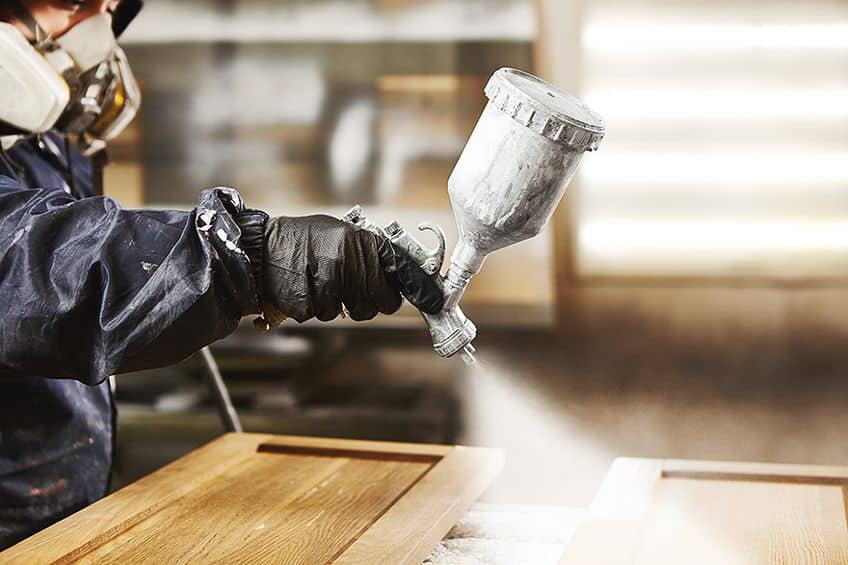
Preparing Your Workspace
It is very important to determine the area you will be working in and to prepare that space accordingly. If you will be working inside you will need to be in a space with good ventilation. Regardless of whether you are working inside or outside, you will need to cover your workspace to catch any stray paint. When your space has been prepared to ensure, you have everything you require. We follow is a list that can assist you:
- Ensure that the spray gun you will be using is specifically designed for furniture
- It is necessary to use a respiratory mask for your safety
- Ensure you have sufficient quantities of paint colors and primer
- Your electrical/airlines need to be free from obstructions
- Have sanding paper and a power sander available
- You will need a microfiber cloth available for cleaning
Preparing Your Workpiece
You can begin by sanding your workpiece down as best as you can. If it is your first time there is a chance that you have missed some areas but do not worry about this too much. As mentioned previously if you have access to a power sander it will save you a significant amount of time if you are tackling a larger project such as cupboard doors, or a tabletop. When you have finished with the larger areas you can then turn to the hard-to-reach places and edges using some sandpaper.
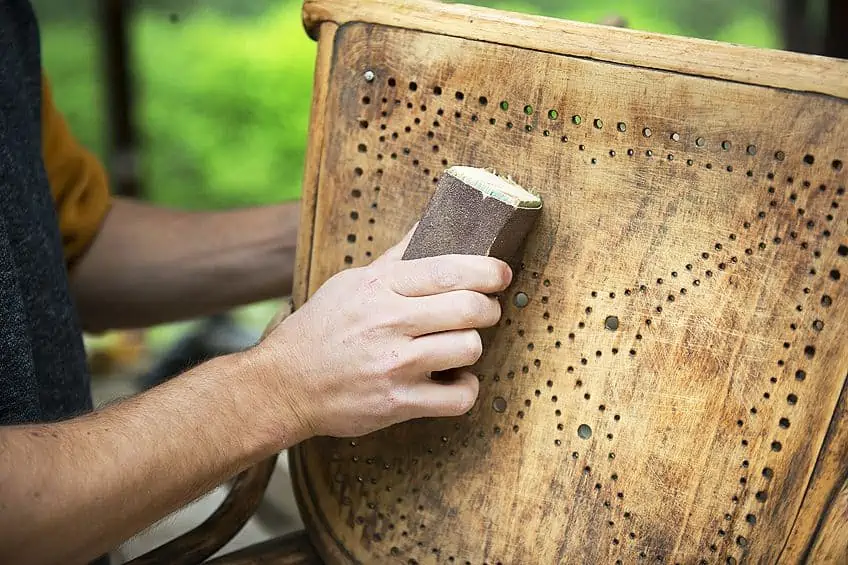
Use a cloth and a vacuum to clean your workpiece off, and then it times to start applying the primer. Primer is great as it assists the paint in adhering to the wood surface and stops the paint from flaking and running. Apply in long, consistent strokes and work from the bottom of the piece to the top so that you ensure even coverage over the whole piece.
Painting Your Piece
When you are certain that your surface is clean and that there are no rogue pieces of wood on the surface you are finally ready to begin painting. The primer needs to have dried completely and you need to have selected a paint color you like. It is time to apply the initial coat. Begin in one direction and move from right to left (or vice versa), apply in a seamless motion with consistent trigger pressure. Try to not hesitate and when your initial coat has been applied allow it sufficient time to dry. When the first coat has dried you can repeat the process until you are happy with the finish you have achieved.
Allow sufficient time for each layer to dry completely and when you are happy you can apply a clear coat. A clear finish will provide your piece with a stunning sheen and will provide protection. Apply your topcoat using the same process of ‘spray, dry, and repeat’.
Tips and Tricks for Spraying Furniture
So, you have decided to use a spray paint gun to revitalize your furniture. We have put together a handful of tips and tricks to help you along the way.
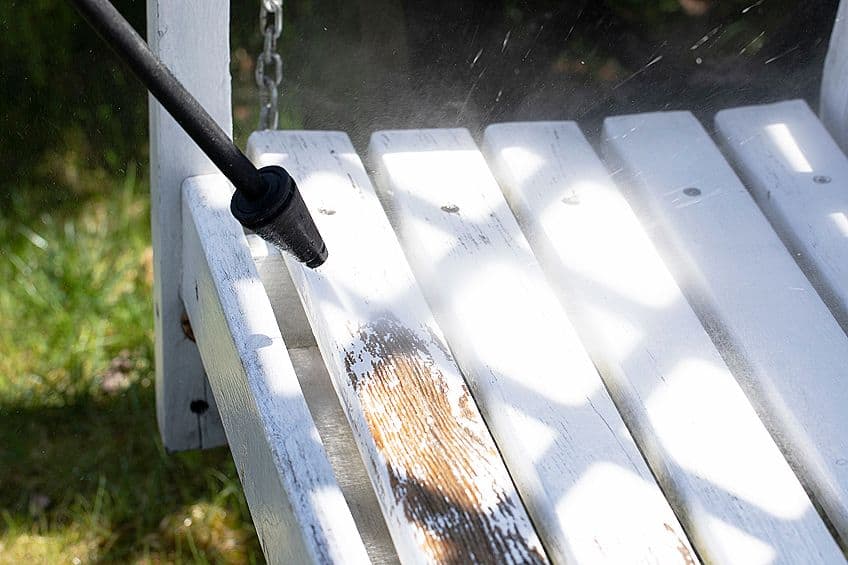
Always Prepare Your Surfaces
You may be eager to begin but we recommend you first prepare your furniture before you wipe out the spray paint gun. Regardless of the material, whether it be canvas furniture, glass, wood, or ceramics you will always have to ensure you first sand and prime the surfaces before you apply the initial layer of paint. You want to ensure that you will not have to restart the whole process as the relevant preparation was not done. Use care and patience when applying your primer and ensure each layer dries completely before applying the next coat.
The Importance of Sanding
Sanding is very important when you are working with a wooden surface to aid the bonding process. Sand the wooden surface as best you can to aid your primer and your initial coat of paint in adhering to the surface. When sanding down your piece you will need to think about a few aspects. If you have to sand down large areas, we highly recommend using a power sander. A power sander will save you from a lot of hard work, but it will also decrease the time you will have to spend sanding.
A power sander does not mean you will not need sandpaper at all, as you will require it to clean up the areas that the power sander has a difficult time reaching and can tidy up the edges.
Slow and Steady Wins the Race
Now that you understand the basics required for preparation you should spend a little time practicing your spraying technique. One may think that the technique to spraying is in your wrist but the actual important aspect is ensuring consistent coating. To achieve this, you will need to move your whole forearm when moving the sprayer. Using the full range of motion increases the level of consistency and control. It will also offer you better control of your trigger finger so that you do not create inconsistent density areas during your application.
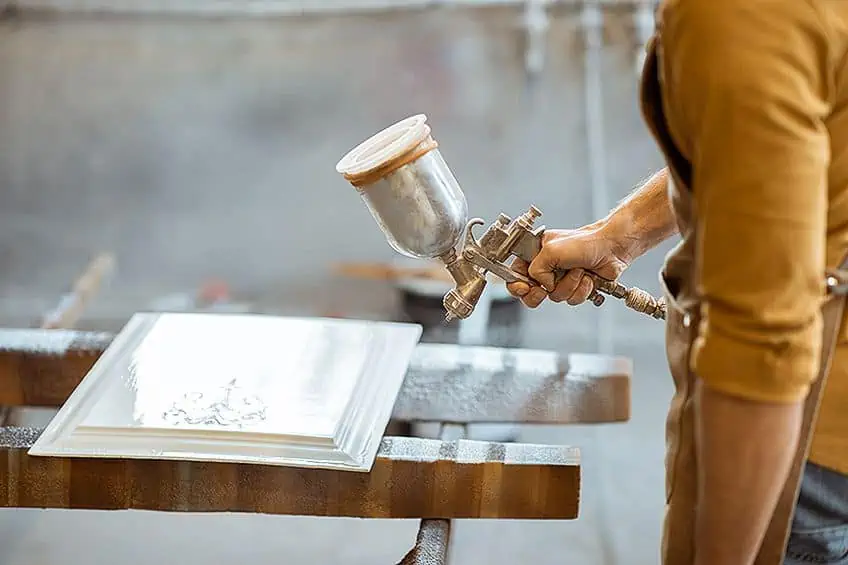
Regardless of whether you are applying primer or your initial coat of paint you need to ensure you are standing at a comfortable distance from your piece. begin spraying from one direction, either right or left whatever works best for you, and spray with a consistent trigger pressure and speed. As always when applying primer or paint, ensure each layer dries completely before you begin to apply the next coat.
So, Is It Necessary to Buy a Paint Sprayer?
This is a completely subjective question. While a paint sprayer is a very versatile tool to own it all depends on if you will be using it enough to justify the expense. That being said you will not necessarily regret owning one if you were to only use it now and again.
The majority of paint sprayers are designed for use for spraying large areas and for the use of people who want to save time by not having to worry about brush strokes or streaks from a paint roller. That being said it is still a useful device for a hobbyist looking to take their work to the next level.
At the end of the day, the choice is yours but we strongly feel there is the correct paint sprayer available for each and everyone’s needs.
Why Spray Paint Your Furniture?
Maybe you have spotted a stunning piece at our local second-hand store that you would love to have in your living room, but requires a little updating. Or you are simply looking at your living room set and it is starting to look a little tired and needs a little updating. Spray painting is a fabulous solution to completely refresh your furniture. Spray painting may seem a little overwhelming to someone who is not familiar with the process or the tools required or someone with no experience.
But with just a little foresight into the process and a bit of practice you might wonder why you have never tried spray painting furniture before!
Advantages of Spray Painting Your Furniture
There are many advantages to spray painting your furniture, and we are sure you are so excited to begin, but we want to outline just how much of an advantage you have from spray painting the furniture as opposed to using a roller or a brush to apply paint.
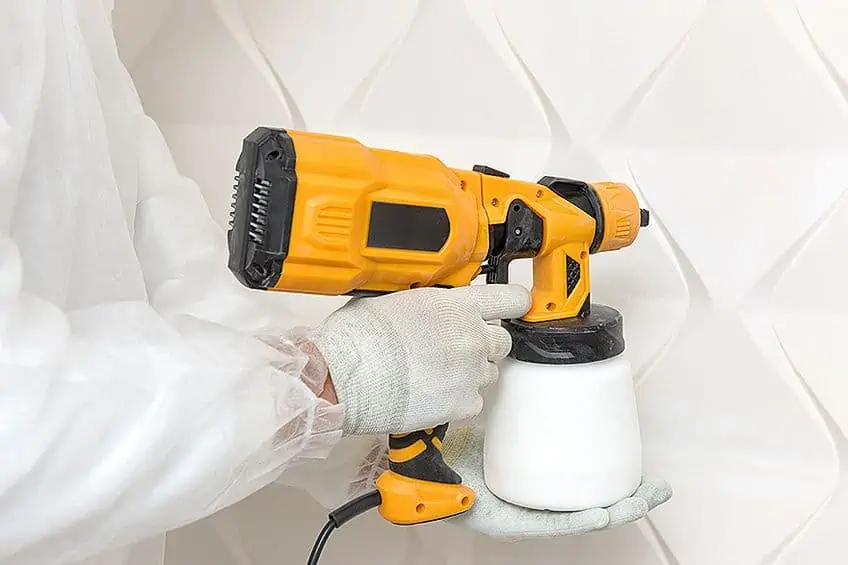
Speed
If you have ever used a roller or a brush to repaint something you will know it is an exhausting and time-consuming process. Spray painting allows you the opportunity to cover a larger surface area in a shorter period and limits the range of motion required to apply paint. This means that you not only save time, but the process is less strenuous on your body.
Eliminates Brush Strokes
How even and smooth your finish is will determine if you have done a good restoration or a bad one. A perfect paint job can be completely ruined by brushstrokes and it is so difficult to try and remove the irritating streaks, particularly if you are chasing a deadline. Spray painting will ensure that there are no brush strokes for you to worry about.
This will give you more time to focus on the final touches without having to check every area of your project for brushstrokes.
Drying
If you must paint an assortment of surfaces on mass, we strongly suggest using water-based spray paint. Even if you haven’t done much painting in your life, you will still know how frustrating it can be to wait for the paint to dry particularly if you are working with a deadline. Your paint will, however, dry much faster if you use a spray gun, regardless if it is oil or water-based. This is due to the spray gun distributing the paint with more even coats than the likes of a roller or brush and due to the paint being applied in thinner layers.
Versatility
There is paint available for every possible project. Selecting the correct paint in the ideal color and consistency can be a bit daunting and who has the time and patience. Paint used for spraying is normally water-based but it might still be necessary to thin out the paint before using it in your spray gun. You can use oil-based paint as long as it has been thinned out, to offer a more durable finish.
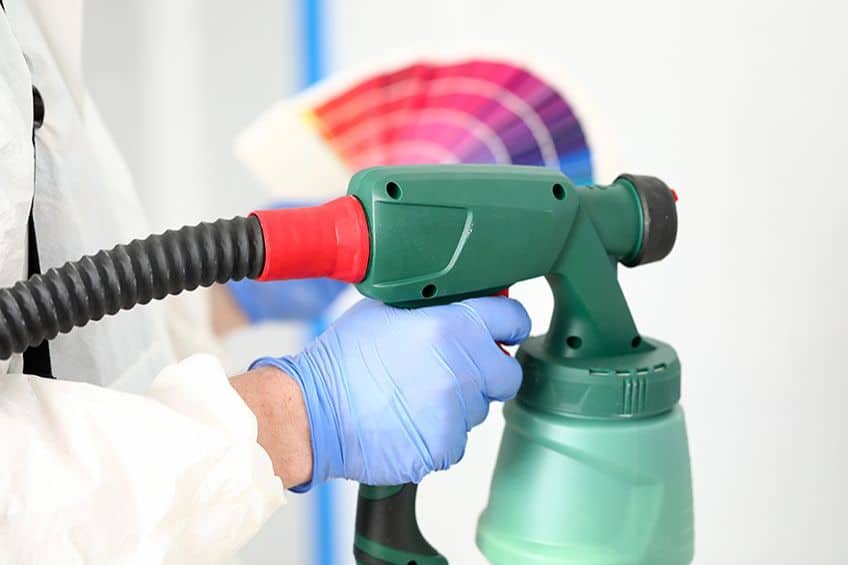
Tidying Up
Imagine the following; rollers and trays all over the place, you covered in paint splatter, and the bristles of your brushes becoming hard as you take a break once you have finished the job. While you might think you are done, the work has only just started as you will need to make storage for any unused paint and will have to clean off any tools you have used. If you have chosen to use a spray painter you will only be tasked with cleaning your paint sprayer and putting it away.
Durability
It can be heartbreaking to see paint peel off a project that you have spent so much time and energy on. It can be an eyesore and very upsetting! Luckily you can just apply several layers of spray paint and a sealant to protect your furniture from the harshest conditions. if you are using an oil-based paint then you will not have to use a sealant thanks to it being a paint that is longer-lasting and durable.
It does not matter if your furniture is being used from time to time or frequently or if it is exposed to harsh weather, your project’s finish will last for a long time.
Getting Those Hard-to-Reach Places
It can be tricky to paint using a brush, even if you are tackling something as ‘straightforward’ as a door. Painting items that have a multitude of facets and crevices can be time-consuming, particularly when trying to ensure consistency and coverage across all the surfaces. By choosing to use a spray painter you eliminate all of these problems. A spray painter provides consistency and coverage and you will avoid the risk of developing carpal tunnel when trying to tackle the harder-to-reach places.
The Pros and Cons of Furniture Paint Spraying
We have already addressed the positive aspects of spray painting your furniture above, but there are some negative aspects to this method of painting so it is best we consider both the pros and cons.
PROS
- Provides durability for both exterior and interior surfaces
- Quicker than using a brush
- Can be used to apply paint to an assortment of materials
- No brush strokes are left
- Great versatility
- Hardly any cleanup required
- Dries very fast
- Offers consistency
CONS
- Spray paint is toxic once inhaled, so you will need to wear a respiratory mask
- Splattering can occur due to blockages in the nozzle
- If you have been spraying for an extended period your trigger finger can cramp
- To cover large areas, it can be quite expensive
What Kind of Furniture Can Be Spray Painted?
You are applied to spray paint on several different surfaces. Keep in mind that there are specific paints for different applications and each specific purpose requires its form of preparation. What follows is a look at the different types of furniture that one can spray paint and how you would go about preparing them.
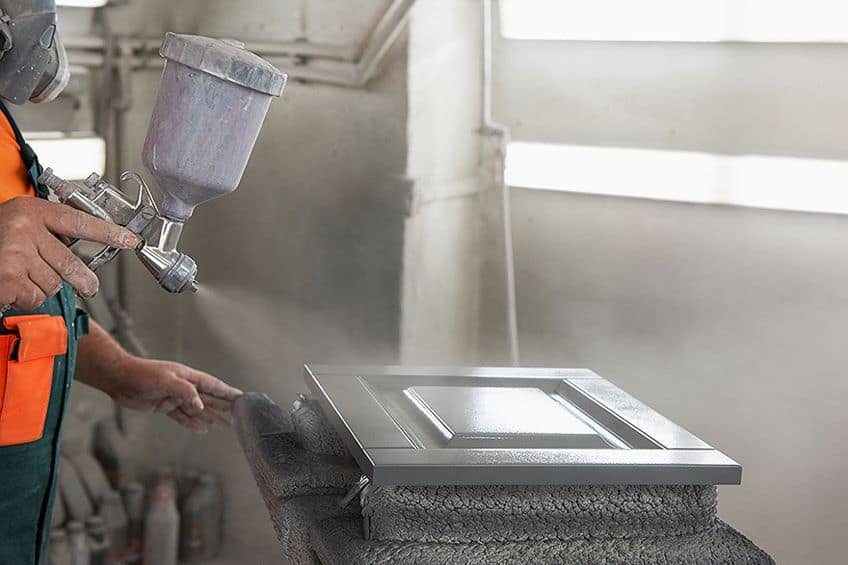
Re-Upholstered Furniture
Granted this might sound a bit strange but it is very much possible to paint re-upholstered furniture and is quite a popular way of revitalizing your faded, old coverings. We suggest you do not attempt this on tattered or worn and thinning materials, as it works best on materials that just need a fresh layer of paint. Remember that if you choose to rather have a professional do this it can get quite costly.
Ceramic Objects
Spray paint is ideal to use on an assortment of embellished decorations. You might want to restore a ceramic piece to update your home or update a garden ornament. Spray painting is the perfect choice when it comes to wanting to liven up your furnishings. Be very careful when working with ceramics as the pressure applied when priming and sanding these pieces could potentially damage them.
Keep in mind that ceramics are naturally shiny so using a finish that has a high level of sheen is what you want to use when working on these types of furniture.
Metallic Surfaces
Maybe you have a family heirloom that has seen better days but you are not ready to get rid of it just yet. With a little hard work, and using some primer, sandpaper, and of course your paint sprayer you will be able to transform the piece into a gorgeous retro item of furniture that you will love. There is an assortment of finishes and colors to choose from so plan out the end look you are aiming for before you begin so you can select the right colors and finishes.
Wood Furniture
This is the surface that is most commonly spray painted as it is the easiest type of furniture to revitalize using spray paint. Wood furniture is simple to prepare and can handle either oil- or water-based paints well. There are no limitations when it comes to working with spray paint and wooden furniture but we do recommend you do a little research in terms of the type of wood you are working with. You can then identify the best techniques to use for that particular wood type, taking its grain and consistency into consideration.
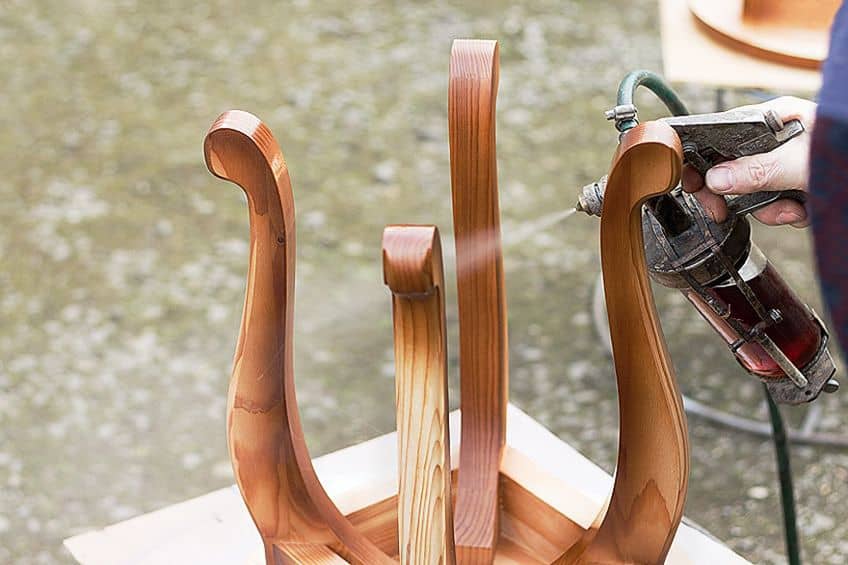
Glass Objects
If you are eager to tackle something a little more challenging then why not use your paint sprayer to transform ornate glass pieces. You would have to use a powered sprayer particularly if the item is brittle or small. To prepare the glass give it a thorough clean and allow it to dry. When the glass has dried wipe it down with a little rubbing alcohol and then you are ready to use the sprayer. You ideally want to apply several even layers and ensure that you are using a paint that is labeled as a glass spray paint otherwise you will have to use a primer first.
Considerations for Buying a Paint Sprayer for Furniture
Selecting the right spray paint gun for furniture can be overwhelming for anyone, even an experienced craftsman. There are many aspects you need to take into consideration when deciding which furniture paint sprayer to purchase. We have put together a list of common aspects for you to take into consideration before you buy.
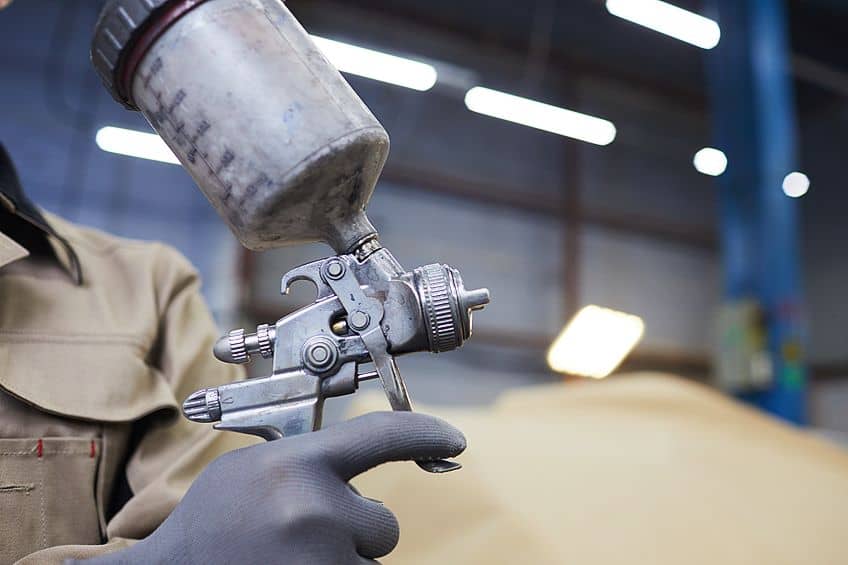
How the Paint is Supplied
Our second recommendation, the Wagner Control Max comes with a two-stage turbine which means that throughout the application process the feed pressure remains consistent which is an amazing feature to have for business owners and hobbyists alike.
You may wonder why consistent pressure-feed is so important, this is because the consistency ensures an even application and decreases orange peel (concentrated areas of paint), and reduces splatter.
There are three ways that the paint can be feed through the nozzle. Your setup can either be pressure-fed, gravity-fed, or siphon-fed it is all dependent on the model and make you have selected. There are positives and negatives to each supply method and it all depends on the kind of work you are looking to do. What follows are the three methods in more detail.
Pressure-Feed Configuration
This is the least commonly seen configuration as a result of its setup begin complex. These sprayers can be expensive depending on the quality and brand of machine which you purchase. Their most common application is for use in high output work environments where efficiency and speed are important. The pressure feed has no canister attached to the sprayer’s body.
The air source which is either turbine or compressor feeds in an independent canister, which then feeds the paint that has been pressurized into your spray nozzle so it can be atomized. There are many advantages to this configuration.
You will also be able to reach small spaces without having to worry about the canister touching the surfaces, upsetting the balance of the sprayer in your hand, or obstructing your view. Yet there are negatives to this configuration such as it being exhausting and time-consuming to clean. Despite this, this unit is considered the best option when it comes to furniture paint spraying.
One of the main advantages is that the sprayer’s center of gravity is not dependent on the position of the paint canister. This is also true for the consistency of the paint atomization.
Gravity-Feed Configuration
This is one of the most used feed configurations for furniture paint spraying. This feed is characterized by the paint canister being on top of the paint sprayer. This means that the canister facing downwards in conjunction with the paint’s weight allows the paint to feed into the body of the sprayer without requiring air pressure. This is great as then the air pressure is only necessary for the atomizing of the paint.
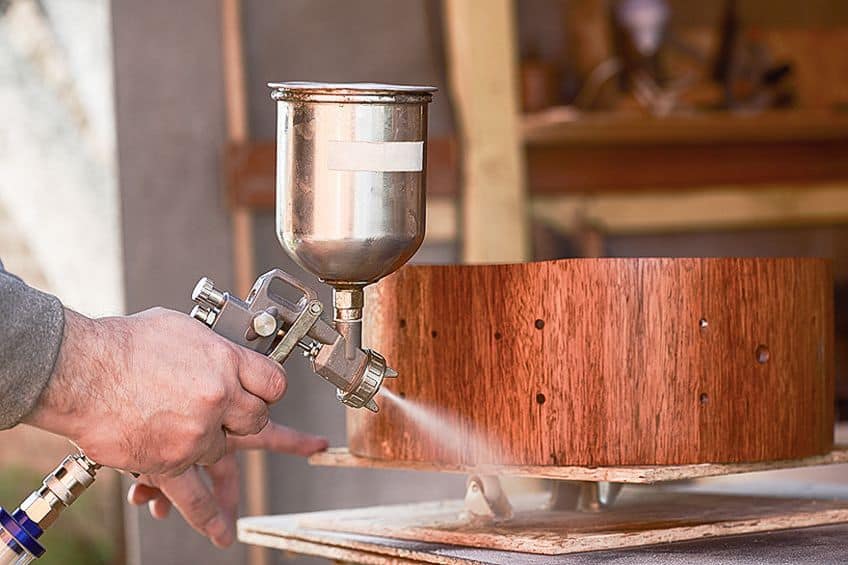
This is ideal if your workspace has a fair amount of space, and when combined with a compressor as opposed to a turbine air feed, this configuration is very versatile. It can prove difficult to get this set up into a confined space, and should you have to invert the sprayer for any reason you will not receive enough paint to the nozzle. There are attachments available that can be combined with this configuration to pressurize the sprayer.
Siphon-Feed Configuration
Thanks to the sprayers being easily available this is a very common configuration. This feed configuration is characterized by the paint canister being attached to the bottom of the body of the spray gun. Sadly, with this configuration gravity is in no way aiding you to feed the paint to the nozzle. You may then wonder how one gets the paint to the nozzle so it can be atomized? The configuration pressurizes the paint canister by siphoning air from the body of the gun. This causes the paint to be forces upwards and allows it to be atomized and then applied to your chosen surface.
In older versions of this configuration, the canister required a vacuum effect, as opposed to being pressurized, to pull the paint upwards.
While this particular method is not used anymore the method is still called the siphon-feed configuration. These feeds are amazing and are relatively versatile when used by someone with experience. They are normally used by hobbyists and offer amazing value for money, whether for commercial or personal use.
Air Supply
Selecting an air supply is very similar to deciding between a gas cooker and an electric stovetop. While each may have its own positive and negative aspects, which you end up selecting depends on what kind of cooking you will be doing (or in our case, painting) you will be doing the most.
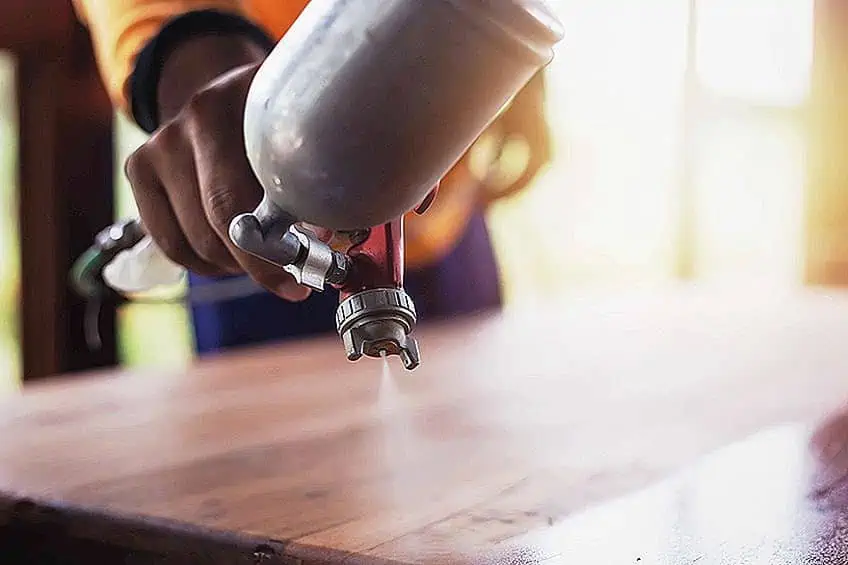
Compressors
If you already own a compressor configuration which you use for other tools or clean-up then it is the best option for your air supply. Compressors are wonderful as they have a level of air ready for you when you require it all that has to happen is you plug it into your sprayer and you can begin.
Sadly, compressors can be very costly and are quite large so they take up a lot of space, particularly with the size of the unit required to supply a spray paint gun for furniture. They are also not as portable, though the smaller capacity does come with wheels attached.
Turbines
Turbines are perfect if you have a limited workspace. They are easy to move around and store, particularly if your work needs some running around. While they do offer consistent air pressure and are very powerful, they do not have as much capacity as commercial compressors.
Dry air is produced by the forced induction of the turbine, so you do not need to use a moisture damper in your sprayer to compensate for this. You will need to take into consideration that you are not able to adjust the pressure from a turbine as it does not become equipped with a pressurized air ‘on tap’ like that found on a compressor.
Hopefully, our article has helped you see just how useful a paint sprayer is when tackling furniture and we hope we have assisted you in the overwhelming decision of which paint sprayer to use.
Frequently Asked Questions
Is Special Paint Required When Using a Paint Sprayer?
The answer all depends on the type of paint sprayer you plan to use. Paint is available in an assortment of consistencies for different applications, so if your paint is slightly too thick it might not work in your paint sprayer. If this is the case, your spray gun and air source might not be able to atomize the paint, and resulting in a huge mess. Always check what the recommendations are for your paint sprayer in terms of the type of paint.
Do Paint Sprayers Create a Mess?
When you start out using a paint sprayer for the first time you will make a mess as you learn to handle it and experiment with the different spray patterns and nozzles. You will need to train your muscle memory in terms of trigger pressure and consistency and this can take a few tries. All of this is a bit messy, but with time as your experience and confidence grow with using a paint sprayer, there will be less mess.
Do You Use More Paint When Working With a Paint Sprayer?
Yes, they do use more paint (roughly 30% more paint) than that of a roller or brush application method. This may seem quite surprising to you if you thought you would be saving on paint, but the time you save using a paint sprayer to revitalize your workpiece should make up for the increase in the amount of paint used.

I have been into woodworking since 2005 and woodturning since 2011. Because of my love for wood and woodworking, I started woodhappen.com to teach other enthusiasts about how to finish and seal wood, the best woodworking tools, the different types of wood, and everything else related to woodworking! Read more about me here.

